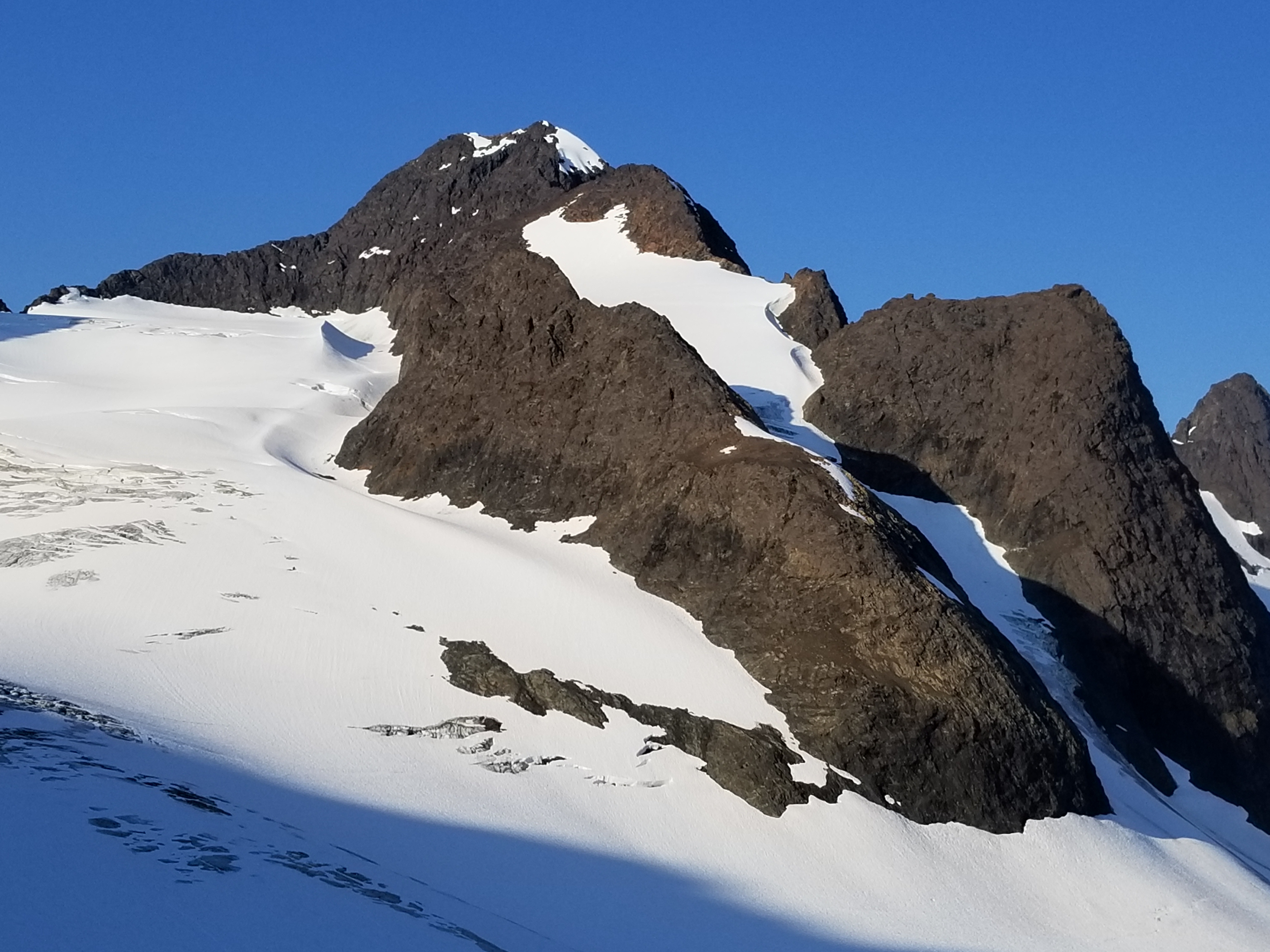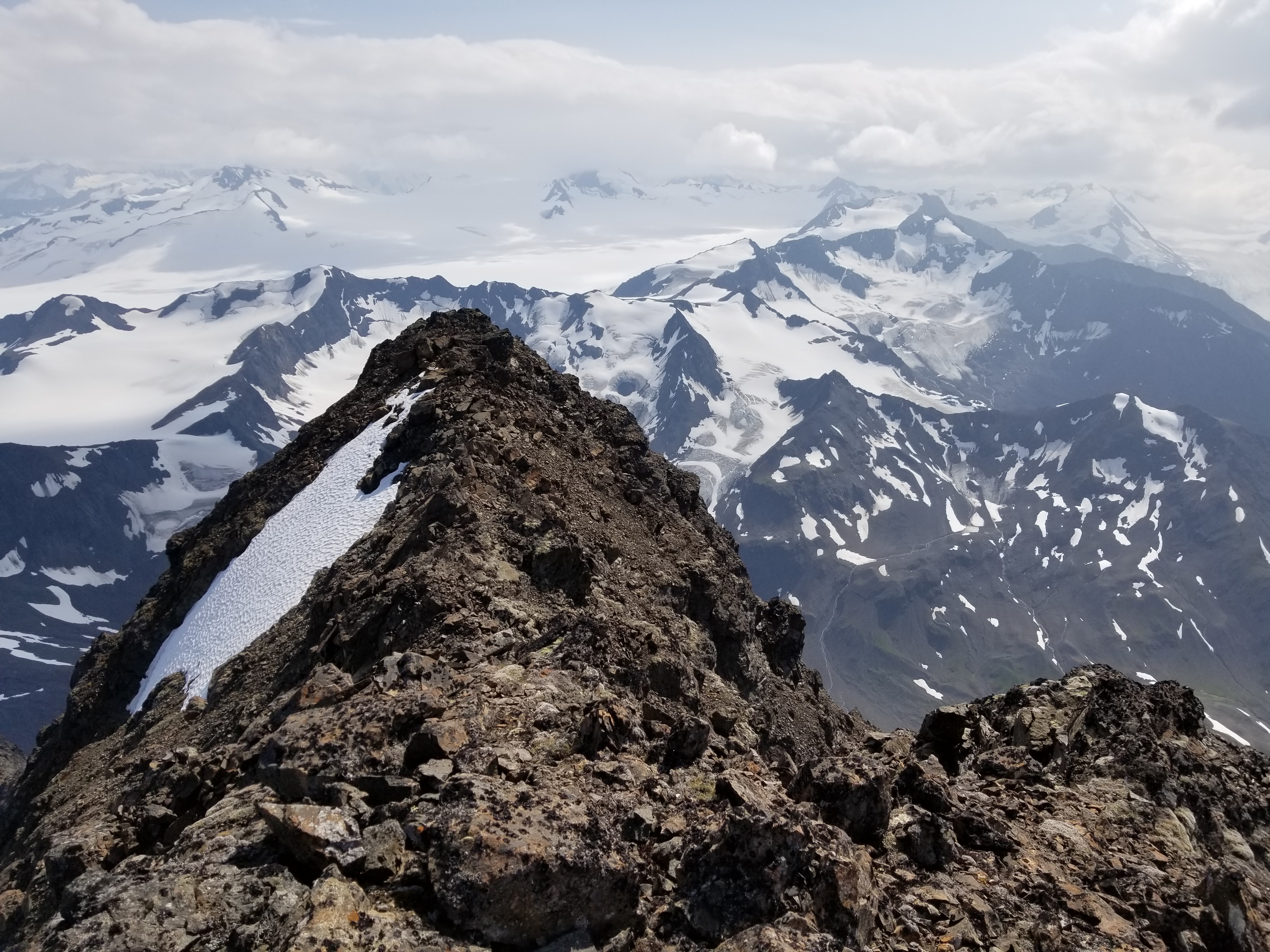Mount Beelzebub
The Devil in the Details
Published 8-6-2023 | Last updated 8-6-2023
61.191, -149.024
GNIS Entry
| History | Named by Art Davidson, Mike Judd, Dave Myers, and Nick Parker, of the Mountaineering Club of Alaska, who were in the first ascent party on this mountain on August 22, 1965. They felt that “this name for the devil was considered appropriate.” |
|---|---|
| Description | In the Chugach Mountains, 10.5 mi S of Eklutna Lake and 29 mi E of Anchorage. |
Many climbers who frequent the Chugach have stories of the heart-stopping feeling of lightly placing a hand on chunks of rock the size of microwaves or even refrigerators, only to feel the entire block shift under those few pounds of pressure from their fingertips. Or desperately searching for a trustworthy handhold on an exposed slope, while feet scrabble to stay put in a layer of kitty litter gravel over a smooth slab. Slipping on loose rock or trusting a handhold which tore out of the mountain has injured or killed incredibly strong and talented climbers. To an even greater extent than most mountain ranges, the Chugach is not fair.
Realistically, the most dangerous of those hair-trigger hazards are the isolated, unexpected ones on terrain which is steep enough to kill, but not steep enough to terrify. They catch climbers when their guard is down. But anticipation is a key component to fear, so those unpredictable landmines can’t seize a person’s attention in the same way as an area which is known to be treacherous. Certain mountains have a reputation for containing extended sections of shattered, untrustworthy rock, and loom large in the consciousness of local mountaineers. When humans head out to climb them, it’s with full concentration and fireworks in the amygdala, typically after years of preparation and practice.
Mount Beelzebub is often regarded as the most fearsome of these in the Chugach State Park. The king of deceivers lurks behind Mount Yukla from a vantage point along the Crow Pass trail, overlooking Thunder Gorge to the south and the shriveling West Fork of the Eklutna Glacier to the north. It is wickedly steep on all sides. Even the standard climbing route, chosen as the easiest way up the mountain, is known for unavoidable sections of loose gravel over thousand-foot drops with nothing solid to cling to.
A route description written by Billy Finley in the birds nest of papers and journals at Pichler's Perch reads “the crux... is seriously exposed and rotten rock with zero protection and a leader fall would certainly be fatal.” In a more accessible account published on his website, Finley describes laying flat on his stomach in a desperate effort to create enough friction to not slide off the mountain.[1] Throughout the decades other members of the small cadre of climbers who have summited mention “questioning both our sanity and route selection,”[2] “nothing to climb on except nubbins,”[3] or quietly refrain from putting the experience into words.
The peak was first climbed in 1965. It was named by Art Davidson, who is best known for participating in the first winter ascent of Denali as described in his book Minus 148. But Art didn’t write an acclaimed bestseller on Beelzebub, and his 1965 trip report merely reads “reaching the summit by mid-day, we named it Mount Beelzebub.”[4] The follow-up application for federal recognition of the name adds very little to describe the inspiration: “this name for the devil was considered appropriate.”[5]
On the surface, that’s straightforward enough. Art later added that it “seemed like kind of a devilish peak because it was all broken up, not a clear route,” and that his party agreed on the “anthropomorphic name. We think it's difficult and devilish, so it's Beelzebub. But it's a B.”[6] That ‘B’ was important to fit the alliteration theme of the region’s other peak names: Bold, Bashful, Baleful, etc. But just like in climbing, sometimes you can probe past the first layer of scree until you stumble across something deeper, more solid, and more interesting. Asked to elaborate on his inspiration for Beelzebub, and how that name might have gotten into his subconscious, all of a sudden Art cheerfully exclaims: “Grrr Jeff”
“...say that again?”
“Gurdjieff!”[6]
George Ivanovich Gurdjieff. A Russian-Armenian philosopher who lived in the Russian and Ottoman Empires and in France from an uncertain birthdate around 1870 until his death in 1949. His magnum opus, published in English in 1950, is titled Beelzebub’s Letters to His Grandson. The book teaches Gurdjieff’s philosophies through a plot involving an alien named Beelzebub observing humans and offering parables exploring metaphysics. But it is very intentionally convoluted, full of rare words and invented vocabulary, and demands concentration and multiple readings to fully grasp. Gurdjieff’s fundamental premise was that “to acquire higher consciousness, people must be awakened from the state of constant sleep. This could be achieved by continuous physical and mental work.”[7]
To help prod students in that direction, Beelzebub’s Letters features “very complex writing, intentionally forcing the reader to ‘work’ on the text to find its meaning. [Gurdjieff] also composed it in his usual manner, writing in noisy cafes to cause a greater effort of concentration.”[7] A student of Gurdjieff’s described a “preference for mystification and his demand for desperate striving. […] He believed that people did not value what they had not paid for.”[8]
And that brings us back to Mount Beelzebub. At first glance the obvious inspiration is demonic, requiring you to place your life on the line in a bargain with gravity and friction to see the summit and return. But the more esoteric layer to the name casts climbing the mountain as a work of concentration, a means of elevating consciousness through extended stretches of complete mental and physical focus. The choss of the Chugach issues its own demand for desperate striving, and its devotees often return from hard climbs feeling a deep sense of physical, mental, and spiritual enrichment.


With gratitude to Art Davidson for coining an excellent name and indulging repeated probing ‘but why?’ questions about the origin of ‘Beelzebub.’
Sources
[2] David Hart. “NNE Ridge of Beelzebub,” The Scree, Mountaineering Club of Alaska, October 1996.
[6] Art Davidson, in discussion with the author. February 2021.
